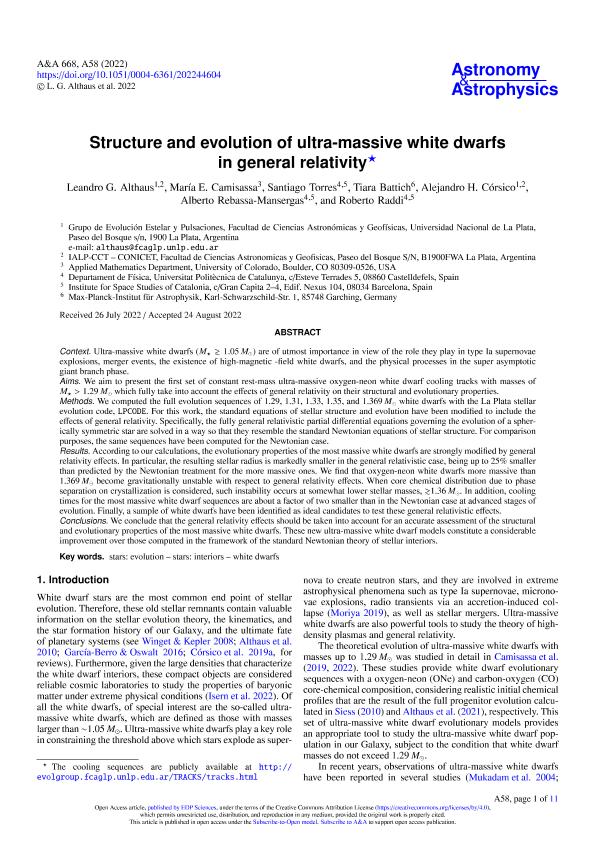Artículo
Structure and evolution of ultra-massive white dwarfs in general relativity
Althaus, Leandro Gabriel ; Camisassa, María Eugenia
; Camisassa, María Eugenia ; Torres, Santiago Hernan
; Torres, Santiago Hernan ; Battich, Tiara
; Battich, Tiara ; Corsico, Alejandro Hugo
; Corsico, Alejandro Hugo ; Rebassa Mansergas, Alberto; Raddi, Roberto Ariel
; Rebassa Mansergas, Alberto; Raddi, Roberto Ariel
 ; Camisassa, María Eugenia
; Camisassa, María Eugenia ; Torres, Santiago Hernan
; Torres, Santiago Hernan ; Battich, Tiara
; Battich, Tiara ; Corsico, Alejandro Hugo
; Corsico, Alejandro Hugo ; Rebassa Mansergas, Alberto; Raddi, Roberto Ariel
; Rebassa Mansergas, Alberto; Raddi, Roberto Ariel
Fecha de publicación:
12/2022
Editorial:
EDP Sciences
Revista:
Astronomy and Astrophysics
ISSN:
0004-6361
Idioma:
Inglés
Tipo de recurso:
Artículo publicado
Clasificación temática:
Resumen
Context. Ultra-massive white dwarfs (M∗ ≳ 1.05 M⊙) are of utmost importance in view of the role they play in type Ia supernovae explosions, merger events, the existence of high-magnetic -field white dwarfs, and the physical processes in the super asymptotic giant branch phase. Aims. We aim to present the first set of constant rest-mass ultra-massive oxygen-neon white dwarf cooling tracks with masses of M∗ > 1.29 M⊙ which fully take into account the effects of general relativity on their structural and evolutionary properties. Methods. We computed the full evolution sequences of 1.29, 1.31, 1.33, 1.35, and 1.369 M⊙ white dwarfs with the La Plata stellar evolution code, LPCODE. For this work, the standard equations of stellar structure and evolution have been modified to include the effects of general relativity. Specifically, the fully general relativistic partial differential equations governing the evolution of a spherically symmetric star are solved in a way so that they resemble the standard Newtonian equations of stellar structure. For comparison purposes, the same sequences have been computed for the Newtonian case. Results. According to our calculations, the evolutionary properties of the most massive white dwarfs are strongly modified by general relativity effects. In particular, the resulting stellar radius is markedly smaller in the general relativistic case, being up to 25% smaller than predicted by the Newtonian treatment for the more massive ones. We find that oxygen-neon white dwarfs more massive than 1.369 M⊙ become gravitationally unstable with respect to general relativity effects. When core chemical distribution due to phase separation on crystallization is considered, such instability occurs at somewhat lower stellar masses, ≳1.36 M⊙. In addition, cooling times for the most massive white dwarf sequences are about a factor of two smaller than in the Newtonian case at advanced stages of evolution. Finally, a sample of white dwarfs have been identified as ideal candidates to test these general relativistic effects. Conclusions. We conclude that the general relativity effects should be taken into account for an accurate assessment of the structural and evolutionary properties of the most massive white dwarfs. These new ultra-massive white dwarf models constitute a considerable improvement over those computed in the framework of the standard Newtonian theory of stellar interiors.
Palabras clave:
STARS: EVOLUTION
,
STARS: INTERIORS
,
WHITE DWARFS
Archivos asociados
Licencia
Identificadores
Colecciones
Articulos(IALP)
Articulos de INST.DE ASTROFISICA LA PLATA
Articulos de INST.DE ASTROFISICA LA PLATA
Citación
Althaus, Leandro Gabriel; Camisassa, María Eugenia; Torres, Santiago Hernan; Battich, Tiara; Corsico, Alejandro Hugo; et al.; Structure and evolution of ultra-massive white dwarfs in general relativity; EDP Sciences; Astronomy and Astrophysics; 668; A58; 12-2022; 1-11
Compartir
Altmétricas



